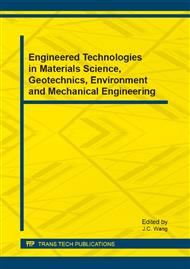p.55
p.59
p.63
p.67
p.71
p.76
p.80
p.85
p.90
Preparation for Humidity Control Composite Paperboard and their Humidity Control Properties
Abstract:
The humidity control composite paperboard with excellent humidity control performance was prepared, comprising sodium chloride, anhydrous potassium carbonate, diatomite, pyrrolidone carboxylic acid-Na, carboxymethyl cellulose and self-made humidity control material. The moisture absorption and desorption rate of the sample are about 0.6231 (g/7h•g-1) and 0.5852 (g/7h•g-1), respectively. The equilibrium humidity fluctuates from 52% to 56% and moisture capacity is 31 %. Moreover, it can reach to the equilibrium levels within 60 minutes. Above all, it shows outstanding humidity control properties, meeting the requirement of micro-environment particularly for something sensitive to humidity such as cultural relic.
Info:
Periodical:
Pages:
71-75
Citation:
Online since:
February 2013
Authors:
Keywords:
Price:
Сopyright:
© 2013 Trans Tech Publications Ltd. All Rights Reserved
Share:
Citation:


